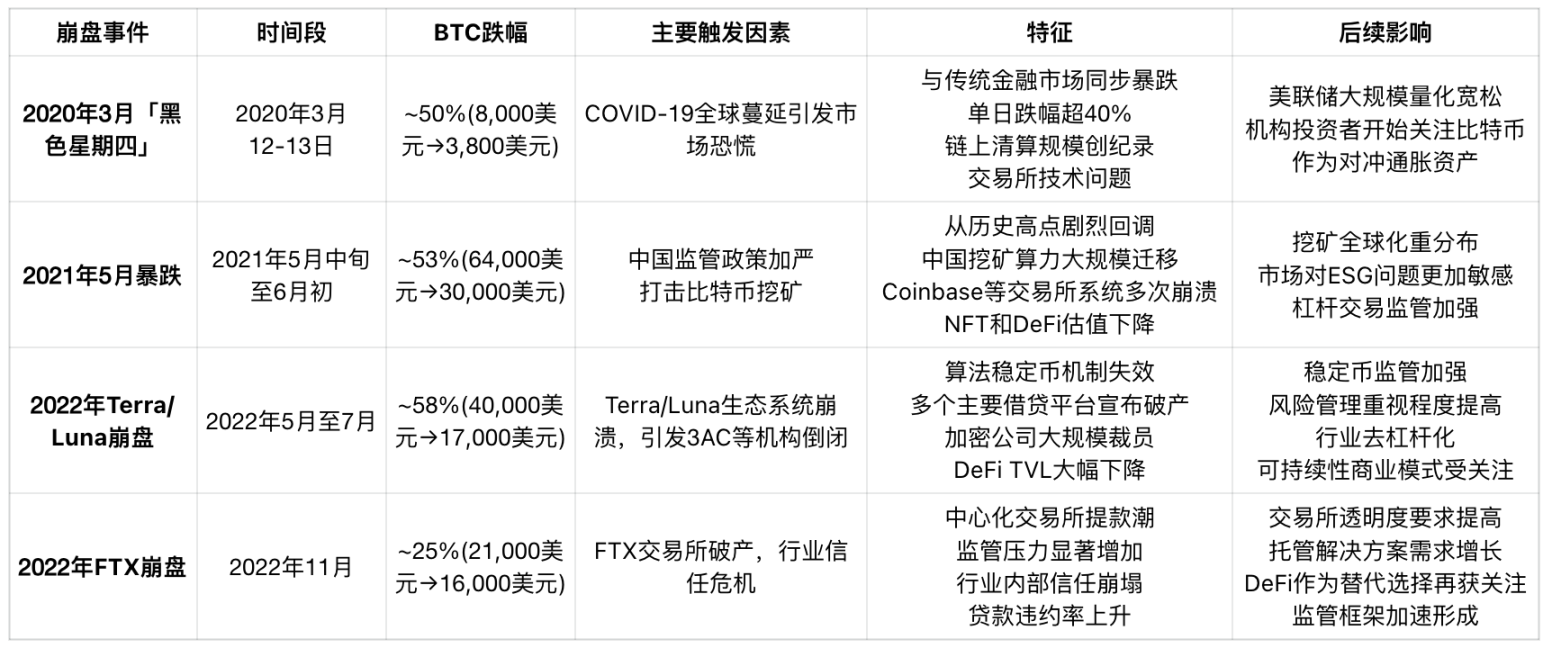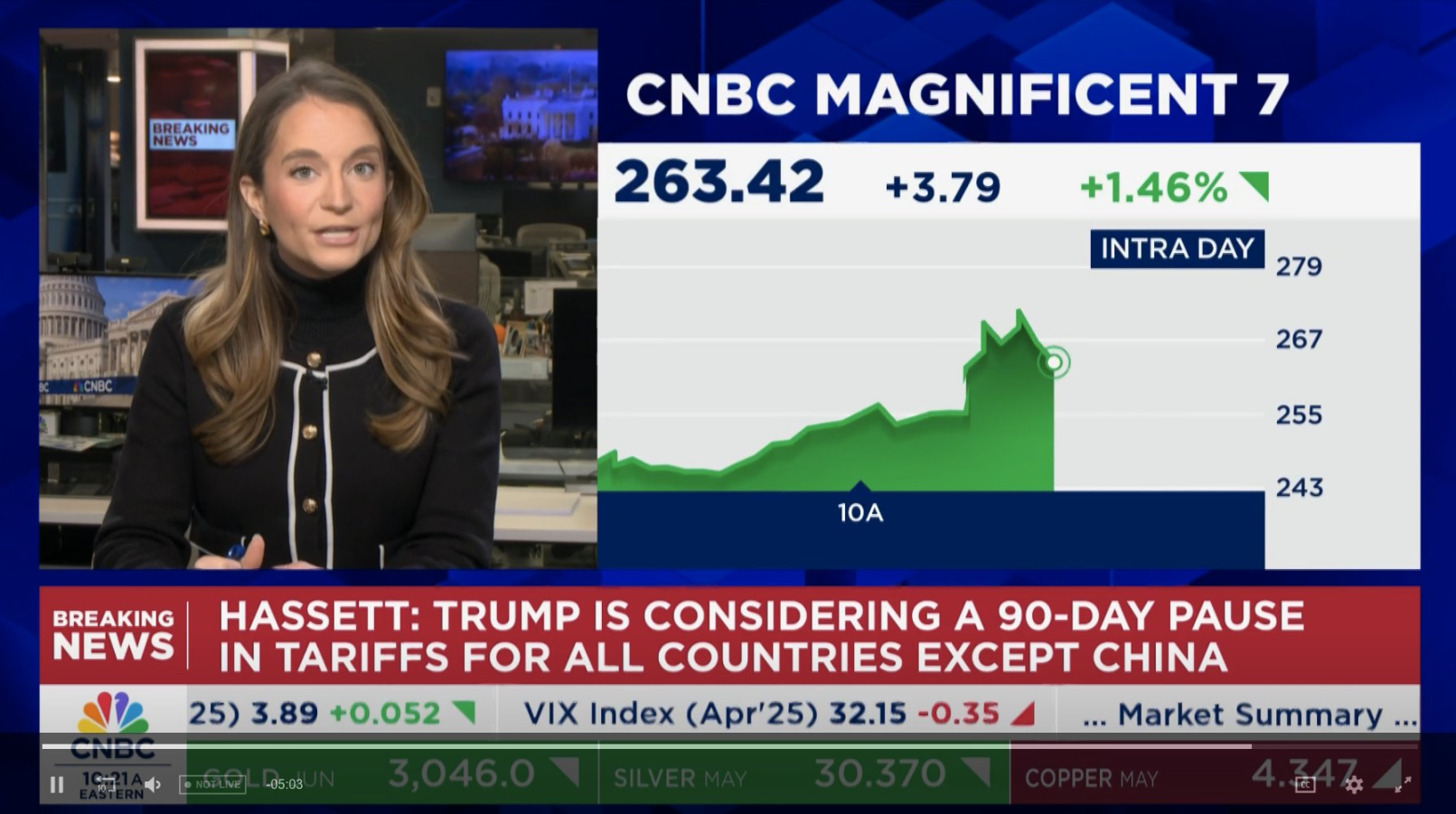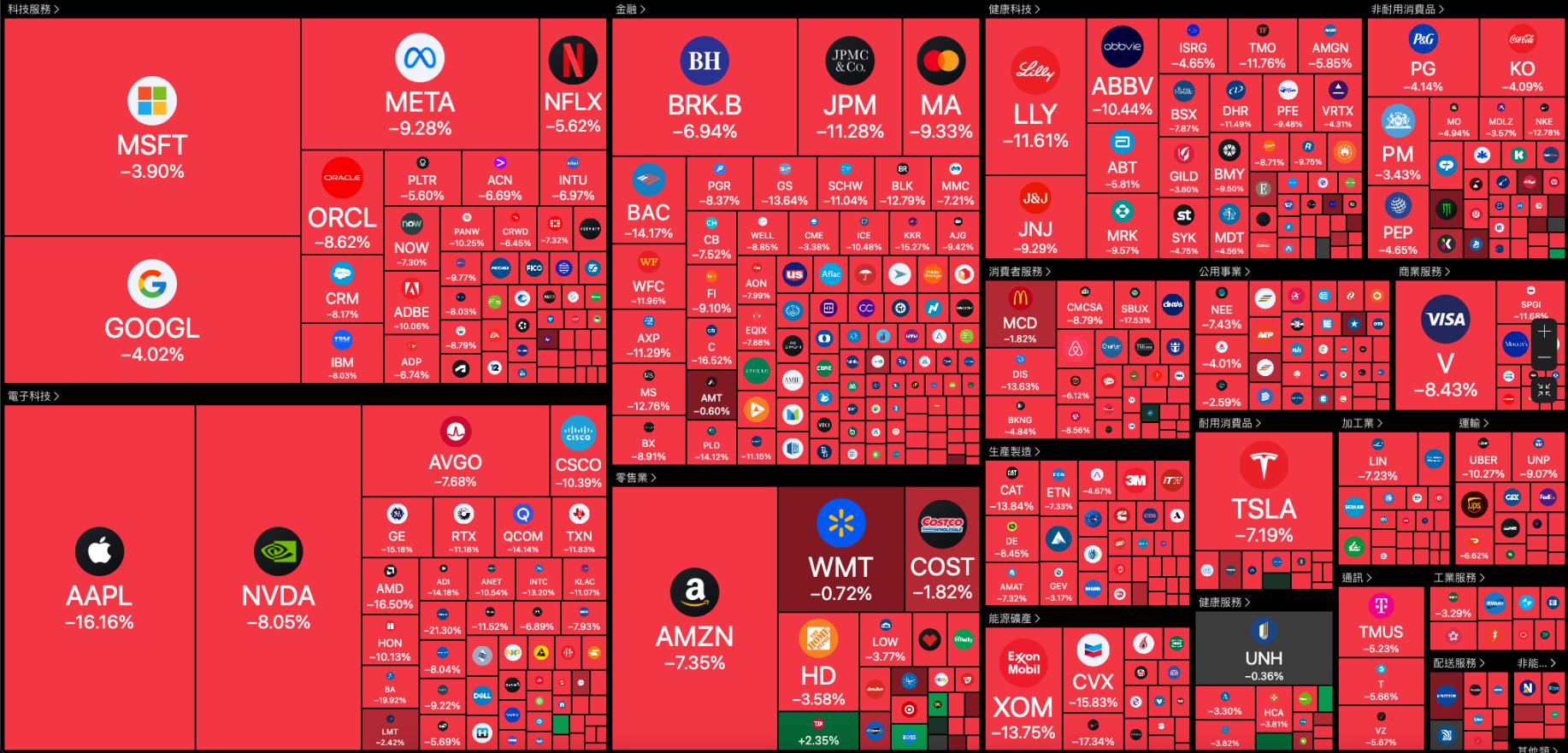Author: ChandlerZ, Foresight News
In April 2025, the crypto market once again fell into turmoil. The Trump administration reintroduced tariffs, causing a sudden shift in global financial market sentiment. Bitcoin dropped over 10% in two days, while Ethereum plummeted by as much as 20%, with liquidation amounts reaching as high as $1.6 billion within 24 hours. Just like previous historic crashes, this scene triggered collective anxiety: "Is this the end, or the beginning of a new collapse?"
However, if we look back at the history of the crypto market, we will find that this is not the first time everyone felt "this is it." In fact, each instance of extreme panic is merely a unique ripple in the asset curve. From "312" to "519," from the global financial panic in 2020 to the "crypto Lehman moment" triggered by the collapse of FTX's credit, and now to this tariff crisis.
The market's script keeps repeating, while investors' memories are always short.
This article will reconstruct the "market scene" of the previous four historic crashes based on real data, comparing dimensions such as price drops, sentiment indicators, and macro backgrounds, attempting to extract a traceable and predictive pattern from these extreme moments: how does the crypto market withstand pressure when risks arise? How does it repeatedly reshape its narrative amid systemic shocks?
Overview of Historic Crashes: Familiar Scripts, Different Triggers
In the past five years, the crypto market has experienced at least four systemic crashes. Although the backgrounds triggering each were different, they all led to severe price adjustments and chain reactions both on-chain and off-chain.

From the data, "312" remains the most brutal in history, with BTC and ETH both dropping over 50% on that day. The total liquidation amount across the network reached $2.93 billion, with over 100,000 people facing liquidation, and the largest single liquidation order valued at $58.32 million. This scale of liquidation indicates that market participants were generally using high leverage (such as 10 times or even higher), and when prices fell rapidly, the forced liquidation mechanism was triggered, further exacerbating selling pressure and creating a vicious cycle.
At the same time, BitMEX's dramatic "pulling the plug" to suspend trading exposed the fragility of market liquidity. Other trading platforms were also thrown into chaos, with Bitcoin's cross-platform price difference reaching as high as $1,000, and arbitrage bots failing due to trading delays and API overload. This liquidity crisis led to a rapid shrinkage of market depth, with buy orders nearly disappearing and selling pressure completely dominating the situation.
As the platform with the largest short position at the time, BitMEX's trading suspension effectively became a "lifeline" that prevented Bitcoin's price from completely hitting zero. Had BitMEX not interrupted trading, the depletion of its depth could have caused prices to plummet close to zero, further triggering a chain collapse on other platforms.
The Domino Effect Under the Black Swan
"312" was not an isolated phenomenon in the crypto market, but a microcosm of the global systemic financial crisis in early 2020.
Panic Crash in Global Stock Markets
Since the Nasdaq index hit a historic high of 9,838 points on February 19, 2020, market sentiment plummeted as the COVID-19 pandemic spread globally. In March, U.S. stocks experienced rare circuit breakers, triggering the mechanism on March 9, 12, and 16. On March 12, the S&P 500 index fell by 9.5%, marking the largest single-day drop since "Black Monday" in 1987, while the VIX panic index surged to a historic high of 75.47. Meanwhile, the three major European stock indices (Germany, UK, France) and the Asia-Pacific markets (Nikkei, Hang Seng) simultaneously entered a technical bear market, with at least 10 countries' stock indices dropping over 20%.
The systemic sell-off in global capital markets quickly spread to all risk assets, with cryptocurrencies like Bitcoin and Ethereum also facing indiscriminate selling in this context, leading to a sharp decline in market risk appetite and the formation of a "financialization resonance" where cryptocurrencies and traditional assets were highly synchronized.
Bloodbath in the Commodity Market
The traditional commodity market also collapsed comprehensively during this crisis. On March 6, 2020, OPEC and Russia failed to reach an agreement on production cuts, prompting Saudi Arabia to launch a price war, announcing increased production and reduced oil prices, which led to a global energy market crash. On March 9, U.S. crude oil (WTI) plummeted by 26%, marking the largest drop since the Gulf War in 1991; by March 18, WTI fell below $20. The uncontrolled plunge of oil, the "blood of the global economy," intensified investors' fears of a deep recession in the global economy.
Additionally, commodities like gold, copper, and silver also saw significant declines, indicating that "traditional safe-haven assets" struggled to hedge against market downturns in the early stages of the crisis, with liquidity panic gradually escalating.
Dollar Liquidity Crisis and the Paradox of Safe-Haven Assets
As global asset prices collectively fell, a dollar liquidity crisis quickly emerged. Investors rushed to sell various assets for cash, pushing the dollar index (DXY) sharply up from 94.5 to 103.0 in mid-March, reaching a three-year high. This "cash is king" phenomenon led to indiscriminate selling of all risk assets, and Bitcoin was no exception.
This was a crisis characterized by liquidity contraction, credit deconstruction, and emotional stampedes, where the boundaries between traditional and crypto markets were completely blurred.
Policy Hammer: The Chinese Crackdown in May 2021
In May 2021, the crypto market suffered a heavy blow. After hitting a historic high of $64,000 in early May, Bitcoin's price halved to $30,000 in just three weeks, with a maximum drop of over 53%. This crash was not due to systemic failures on-chain, nor was it directly impacted by the macroeconomic cycle; its main cause was a series of high-pressure regulatory policies issued by the Chinese government.
On May 18, the Financial Stability Development Committee of the State Council of China explicitly stated the need to "crack down on Bitcoin mining and trading activities." The next day, several provinces began to implement targeted mining rectification measures, including Inner Mongolia, Qinghai, and Sichuan, which are major computing power cluster areas. A large number of mining farms were forced to shut down, and computing power rapidly withdrew from the global network, leading to a nearly 50% drop in Bitcoin's total network computing power within two months.
At the same time, domestic trading platforms faced scrutiny of their bank account interfaces, and OTC channels tightened, causing pressure for capital to flow back. Although mainstream exchanges had gradually exited the Chinese market since 2017, the "policy pressure" still triggered a risk-averse sentiment among global investors.
On-chain, the block interval for miners significantly increased, with single block confirmation times soaring from 10 minutes to over 20 minutes, causing network congestion and skyrocketing transaction fees. Meanwhile, market sentiment indicators plummeted, with the crypto fear and greed index entering the "extreme fear" zone, as investors' concerns over the continuous escalation of policies became the dominant force in the short term.
This round of crashes marked the first time the crypto market faced a confidence reconstruction process triggered by "state-level suppression." In the long run, the migration of computing power unexpectedly promoted the rise of North America's computing power share, becoming a key turning point in the geographical pattern of Bitcoin mining.
Systemic Chain Collapse: The Terra/Luna and DeFi Trust Crisis
In May 2022, the algorithmic stablecoin UST of the Terra ecosystem depegged, triggering a "Lehman moment" in the decentralized finance world. Bitcoin had slowly retreated from its early-year price of $40,000 to around $30,000, and as the UST mechanism failed, the price of Luna dropped to zero within days, causing the DeFi ecosystem to quickly become unbalanced, with BTC's price further plummeting to $17,000, and the entire adjustment period lasting until July, with a maximum drop of 58%.
UST was originally the largest algorithmic stablecoin by market capitalization in the crypto world, relying on Luna as collateral for its stability mechanism. When the market began to question UST's stability, panic spread rapidly. From May 9 to 12, UST continued to depeg, and Luna's price plummeted from $80 to below $0.0001, causing the entire ecosystem to collapse within five days.
Due to the Luna Foundation Guard previously using over $1 billion in Bitcoin reserves to support UST's exchange rate stability, but ultimately failing to prevent the collapse, this portion of BTC assets further exacerbated market pressure during the sell-off. Meanwhile, many DeFi projects within the Terra ecosystem (Anchor, Mirror) saw their on-chain TVL drop to zero, resulting in significant losses for users.
This collapse triggered a chain reaction: the large crypto hedge fund Three Arrows Capital (3AC) held substantial UST and Luna-related positions, and after the explosion, its funding chain broke; subsequently, several CeFi lending platforms, including Celsius, Voyager, and BlockFi, also experienced bank run crises, ultimately entering bankruptcy proceedings.
On-chain performance saw a sharp increase in ETH and BTC transaction volumes as investors attempted to withdraw from all high-risk DeFi protocols, leading to a drastic drop in the depth of multiple on-chain liquidity pools and skyrocketing DEX slippage. The entire market entered a state of extreme panic, with the fear and greed index falling to its lowest level in recent years.
This was a "global correction" of the internal trust model of the crypto ecosystem, shaking the feasibility expectations of "algorithmic stablecoins" as financial centers, while prompting regulators to redefine the risk scope of "stablecoins." Subsequently, stablecoins like USDC and DAI gradually emphasized collateral transparency and auditing mechanisms, with market preferences clearly shifting from "yield incentives" to "collateral security."
Trust Collapse: The FTX Explosion Triggering an Off-Chain Credit Crisis
In November 2022, the centralized exchange FTX, hailed as the "anchor of institutional trust," collapsed overnight, becoming one of the most impactful "black swan" events in crypto history after Mt. Gox. This was a collapse of internal trust mechanisms, directly striking at the credit foundation of the entire crypto financial ecosystem.
The incident began with a leaked Alameda balance sheet, revealing its substantial holdings of its own platform token FTT as collateral, raising widespread doubts about asset quality and solvency. On November 6, Binance CEO Changpeng Zhao publicly announced the sale of his FTT position, causing the price of FTT to plummet and triggering a panic withdrawal wave among off-chain users. Within 48 hours, the FTX platform fell into a liquidity crisis, unable to meet customer withdrawals, and ultimately filed for bankruptcy protection.
The FTX explosion directly pulled down Bitcoin's price from $21,000 to $16,000, with a drop of over 23% within seven days; Ethereum fell from around $1,600 to below $1,100. The liquidation amount within 24 hours exceeded $700 million, and although it was not as large as "312," the crisis occurred off-chain and affected multiple mainstream platforms, resulting in a loss of trust far exceeding what a single price drop could reflect.
On-chain, the exchange volumes of USDT and USDC surged dramatically as users rushed to withdraw from exchanges and transfer assets to self-custody wallets. The number of active addresses in cold wallets reached an all-time high, and "Not your keys, not your coins" became the main theme on social media platforms. Meanwhile, the DeFi ecosystem remained relatively stable during this crisis, with on-chain protocols like Aave, Compound, and MakerDAO not experiencing systemic risks, thanks to transparent liquidation mechanisms and sufficient asset collateral, reflecting an initial validation of the resilience of decentralized architecture.
More significantly, the collapse of FTX prompted global regulatory bodies to reassess the systemic risks in the crypto market. The U.S. SEC, CFTC, and financial regulators from multiple countries initiated investigations and hearings, pushing compliance topics such as "exchange transparency," "proof of reserves," and "off-chain asset audits" to the forefront of mainstream agendas.
This crisis was no longer just about "price fluctuations," but rather a comprehensive handover of the "trust baton." It forced the crypto industry to shift from superficial price optimism back to fundamental risk control and transparent governance.
Systemic External Pressure Triggered by the 2025 Tariff Crisis
Unlike the internal crises in the crypto industry, such as the FTX collapse, the recent market crash triggered by Trump’s imposition of "minimum baseline tariffs" once again showcased the global characteristics reminiscent of the "312" incident. It was not the collapse of a single platform or the loss of control over a specific asset, but rather a systemic financial panic triggered by macro-level geopolitical conflicts, dramatic changes in global trade structures, and uncertainties in monetary policy.
On April 7, U.S. stocks continued to open lower, with tech and chip stocks suffering heavy losses. Nvidia fell over 7%, Tesla nearly 7%, Apple over 6%, and Amazon and AMD dropped over 5%, while Intel and ASML fell more than 3%. Blockchain-related stocks also saw widespread declines, with Coinbase and Canaan Technology both dropping around 9%.
Interestingly, after market rumors suggested that Trump was considering a 90-day suspension of tariffs on certain countries, the S&P 500 index initially fell over 4.7% but then rebounded nearly 3.9%. The Dow Jones Industrial Average dropped over 4.4% before rising more than 2.3%, and the Nasdaq fell nearly 5.2% before climbing over 4.5%, with BTC breaking above $81,000.

Subsequently, the White House told CNBC that any claims about a 90-day suspension of tariffs were "fake news," leading global capital markets to decline again. This illustrates the pressure that Trump's tariff policy exerts on the global financial market.

Traversing Multiple Crashes: Causes of Risk, Transmission Paths, and Market Memory
From "312" to the "Tariff War," several major crash events in the crypto market depict the different types of systemic pressures faced by this emerging asset class. These crashes reflect not only differences in "magnitude of decline" but also the evolutionary trajectory of the crypto market in terms of liquidity structure, credit models, macro coupling, and policy sensitivity.
The core difference lies in the "hierarchical" changes of risk sources.
The "312" incident in 2020 and the tariff crisis in 2025 both represent crashes dominated by "external systemic risks," driven by a "cash is king" sentiment, leading to a collective sell-off of on-chain and off-chain assets, showcasing the extreme interconnectedness of global financial markets.
The FTX and Terra/Luna events illustrate crises of "internal credit/mechanism collapse," exposing structural vulnerabilities under centralized and algorithmic systems; the Chinese policy crackdown represents a concentrated manifestation of geopolitical pressure, demonstrating how the crypto network passively responds to sovereign-level forces.
Beyond these differences, there are also some noteworthy commonalities:
First, the "emotional leverage" in the crypto market is extremely high. Every price correction is rapidly amplified through social media, leveraged markets, and on-chain panic behavior, leading to stampedes.
Second, the risk transmission between on-chain and off-chain is becoming increasingly tight. From the FTX collapse to the 2025 whale liquidations on-chain, off-chain credit events are no longer limited to "exchange issues," but can transmit to on-chain, and vice versa.
Third, the market's adaptability is increasing, but structural anxiety is also rising. DeFi demonstrated resilience during the FTX crisis, but exposed logical flaws during the Terra/Luna collapse; on-chain data is becoming more public and transparent, yet large liquidations and whale manipulations still often trigger severe volatility.
Finally, each crash pushes the crypto market towards "maturation," not in terms of stability, but complexity. Higher leverage tools, smarter liquidation models, and more complex game roles mean that future crashes will not be fewer, but the understanding of them must be deeper.
It is worth noting that each crash has not ended the crypto market. On the contrary, it has driven deeper structural and institutional reconstruction within the market. This does not mean that the market will become more stable as a result; rather, increasing complexity often implies that future crashes will not be fewer. However, understanding the severe price fluctuations of such assets must be deeper, more systematic, and more compatible with the dual dimensions of "cross-system shocks" and "internal mechanism imbalances."
These crises tell us not that "the crypto market will ultimately fail," but that it must continuously seek its positioning between the global financial order, the concept of decentralization, and the mechanisms of risk games.
免责声明:本文章仅代表作者个人观点,不代表本平台的立场和观点。本文章仅供信息分享,不构成对任何人的任何投资建议。用户与作者之间的任何争议,与本平台无关。如网页中刊载的文章或图片涉及侵权,请提供相关的权利证明和身份证明发送邮件到support@aicoin.com,本平台相关工作人员将会进行核查。




